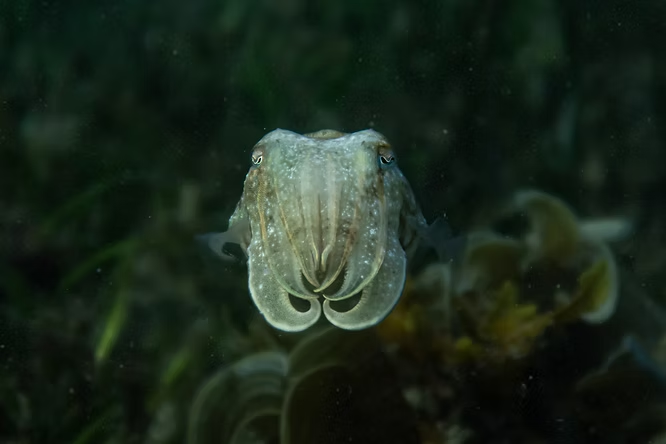Description and Behavior
The broadclub cuttlefish (Sepia latimanus), first described in 1832, is one of the largest and most striking cephalopods. Its oval mantle and crescent-shaped clubs make it instantly recognizable, with individuals reaching up to 50 cm in length and weighing as much as 10 kg.
This species is celebrated for its extraordinary ability to shift colors and textures. Most often, broadclubs display light brown or yellow tones marked with white mottling. Males can turn a deep brown, especially during courtship, while their arms feature bold white and brown bands that transform into dramatic blotches when extended. Their dorsal mantle is decorated with saddle-like patterns, narrow transverse bands, and striking white stripes. Yellow-rimmed eyes and pale fins with crisp white edges complete their vivid appearance.
Another distinctive feature lies in their arm suckers, which vary greatly in size. Their cuttlebone is rounded at both ends, with a convex dorsal surface that flattens near the front. The dorsal mantle carries clusters of large papillae, with elongated papillae running along the base of each fin, enhancing their textured camouflage.
World Range and Habitat
Broadclub cuttlefish inhabit vast stretches of the Indo-Pacific. Their distribution ranges from southern Mozambique across the Indian Ocean, through the Malacca Strait and Melanesian Islands, and as far north as southern Japan. They are also abundant in Southeast Asia, Indonesia, and northern Australian waters, extending to the southern Great Barrier Reef, the Coral Sea, Palau, Guam, New Caledonia, Fiji, and the Cocos (Keeling) Islands.
Typically, they dwell in shallow tropical seas, favoring coral reef environments at depths of up to 30 meters. These habitats offer both abundant prey and effective shelter for breeding and juvenile development.
Feeding Behavior
Active primarily during the day, broadclub cuttlefish employ a mesmerizing hunting strategy. They project rhythmic bands of color across their bodies, seemingly entrancing prey before striking. Their diet includes small fishes and crustaceans, captured with lightning-fast precision.
Life History
Breeding occurs in shallow waters between January and May. During this season, males fiercely defend coral territories where females lay eggs. Courtship rituals are highly visual, with males performing striking displays to attract mates and deter rivals.
Mating takes place head-to-head, with the male transferring spermatophores to the female’s buccal membrane. Once deposited, eggs harden quickly, securing them firmly within the coral and making them difficult for predators to dislodge. After 38 to 40 days, the eggs hatch into juveniles that cleverly hide among coral rubble, often mimicking floating mangrove leaves for protection.
This intricate life cycle, from ritualized mating to remarkable camouflage, reflects the evolutionary adaptability that makes the broadclub cuttlefish one of the most captivating species of the reef.

